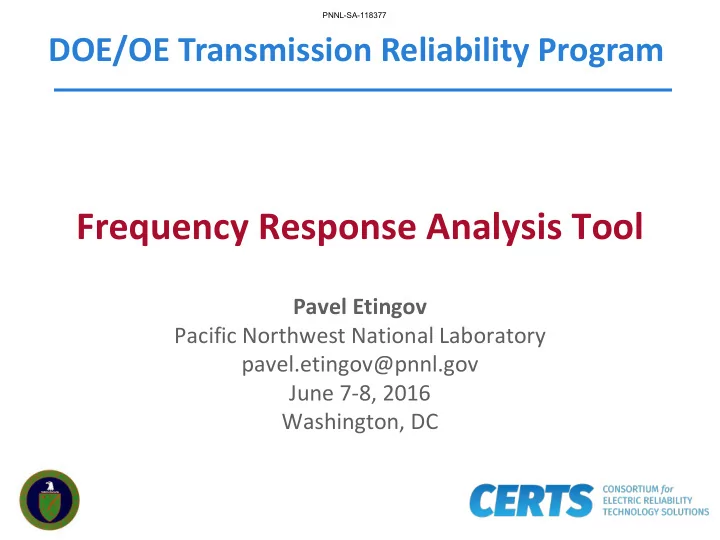

PNNL-SA-118377 DOE/OE Transmission Reliability Program Frequency Response Analysis Tool Pavel Etingov Pacific Northwest National Laboratory pavel.etingov@pnnl.gov June 7-8, 2016 Washington, DC
Project Objectives • Federal Energy Regulatory Commission (FERC) defines in RM13-11: “Frequency response is a measure of an Interconnection’s ability to stabilize frequency immediately following the sudden loss of generation or load, and is a critical component of the reliable operation of the Bulk- Power System, particularly during disturbances and recoveries.” North American Electric Reliability Corporation (NERC) developed • Frequency Response BAL-003-1 Standard, FERC approved the standard with effective date April 1 st 2015. • The frequency response measure (FRM) can be computed from the single event frequency response data (SEFRD).
Project Objectives • The main objective of the project is to continue enhancements of the Frequency Response Analysis Tool (FRAT) • FRAT application: – Released under an open source license – The tool calculates Frequency Response Measure (FRM) according to NERC BAL-003 standard. – The tool archives the historical events and baselines the system performance. – The tool automatically generates NERC Frequency Response Survey (FRS) reports – The tool has built in statistical analysis and advanced visualization capabilities
Frequency Response Analysis Tool • Developed under Bonneville Power Administration (BPA) and WECC JSIS technical guidance • Frequency response monitoring – Interconnection • Balancing Authority – Power Plant • Calculation NERC FRM using PMU and SCADA measurements • Compliance reporting • Baselining frequency response for interconnection and BA • Supporting different data sources (csv, xml, OSIsoft PI, COMTRADE) • Statistical Analysis
Past major accomplishments FRAT (version 1.0) was released under • an open source license in 2013 • FRAT (version 2.0) was released under an open source license in September 2014 • Received positive feedback from multiple industrial users including BPA, NERC, and WECC JSIS • Development was funded by DOE and BPA
FRAT 2.0 Standalone Windows application • • New analytical functions including: – Calculation of the interconnection and balancing authority frequency response measure (FRM) according to the NERC BAL-003-01 Standard – Calculation of the power plant frequency response – Statistical analysis • Redesigned user interface based on WPF framework • Advanced visualization • Automated reporting capabilities • Support of different data sources
Technical Accomplishments FY16 • New version is expanded to national use; • Multiple improvements based on NERC feedback – Time zones support – NERC BAL-003 and M4 events screening – Point C’ calculation • GUI improvements • New reporting capabilities • Connectivity to OSIsoft PI database.
FRAT use at BPA • Bonneville Power Administration (BPA) is one of the early users of FRAT • BPA provides feedback on the application development • BPA uses frequency response baseline developed by FRAT for preparing its filings in response to FERC NOPR on BAL-003-1 • BPA uses the application for baselining its BA frequency response and determining the inventory of its frequency responsive reserves • BPA uses the application to monitor the impact of renewable generation on its frequency response performance
FRAT use at NERC • NERC worked closely with PNNL to make improvements to the FRAT for interconnection-wide frequency response analysis • NERC using FRAT for event tracking for BAL-003-1 and ALR 1-12 (M4) events • NERC using FRAT to generate the database of performance values for frequency response events for each of the four interconnections • NERC using FRAT for determination of BAL-003-1 factors – Interconnection Frequency Response Obligation (IFRO) – Balancing Authority Frequency Response Obligations (BA FRO)
FRAT use at NERC Eastern Interconnection ERCOT Quebec Interconnection Western Interconnection *IFRO values are from 2014 FRAA Report
FRAT main GUI
Interconnection Performance
Balancing Authority Performance FRO=81 MW/0.1Hz * Interchange response is measured for compliance with NERC BAL-003-1 Generation response is calculated to determine how much frequency response to acquire 13
Baselining
OSIsoft PI database support • Read information from PI server • Configurable presets • Time-series aligning • Simple math operations (Sum of several signals, P and Q calculation)
Automated reporting User defined reporting range Export to Excel
Export report to Word
Deliverables FY16 • Conference paper will be presented at IEEE General meeting in July 2016. • Latest version of the Frequency Response Analysis Tool and software documentation. Available at: – PNNL web page: https://svn.pnl.gov/FRTool – NASPI software exchange portal # Milestone/Deliverable Target Date 1 Tool specification December 2014 (completed) 2 Prototype version of the tool March 2015 (completed) 3 Incorporate user feedback and revise prototype September 2015 (completed) 4 Final tool release December 2015 (completed)
Industry Outreach The FRAT application has been presented at multiple industrial events including: • NERC Synchronized Measurement Subcommittee (SMS) • NASPI working group meeting • GIGRE Grid of the Future Symposium • WECC Joint Synchronized Information Subcommittee (JSIS) WECC Modeling and Validation Work Group (MVWG) • • Webinars for different electrical utilities • IEEE General Meeting (to be presented)
Risk factors • Risk factors are low. • Feedback and guidance from industrial users are very important for the success of the project.
Future plans Completed Projects (GMLC) Machine CERTS FRAT Learning BPA Data Readers GM0072 (BPA) CERTS Event Detection Event PPMV GMLC BPA Detection Open Source FRAT PPMV Suite for ARRA (BPA) PMU analysis LMDT Kalman New CERTS Filter OBAT LMDT ARRA FOD (BPA) CERTS Oscillation (GMLC) project Load Modeling FRAT – Frequency Response Analysis Tool PPMV – Power Plant Model Validation Tool LMDT – Load Modeling Data Tool FOD – Forced Oscillation Detection OBAT – Oscillation Baselining and Analysis Tool
Open Platform for Engineering Applications • Based on Open Source Components – Extended WPF Toolkit™ – OxyPlot – Math.NET • Create building blocks and solutions for future and 3 rd party applications • Common data structure and data exchange protocols • Support external modules/solvers – Oscillation Analysis – Model Calibration
Recommend
More recommend